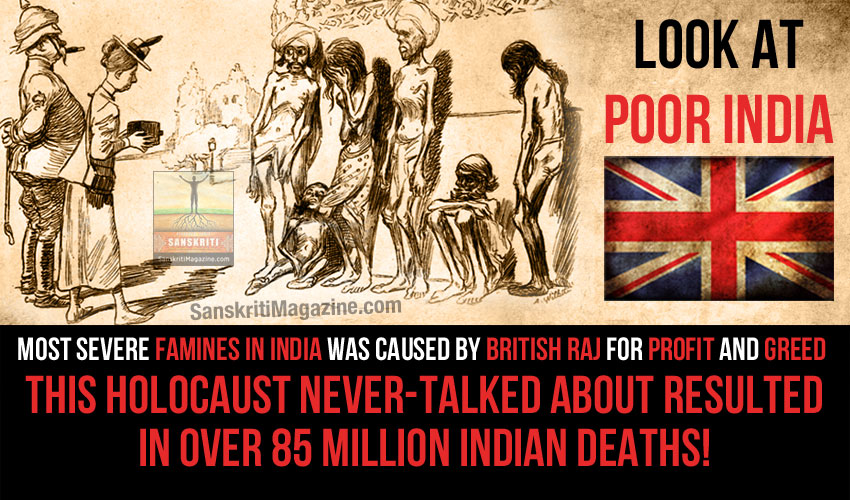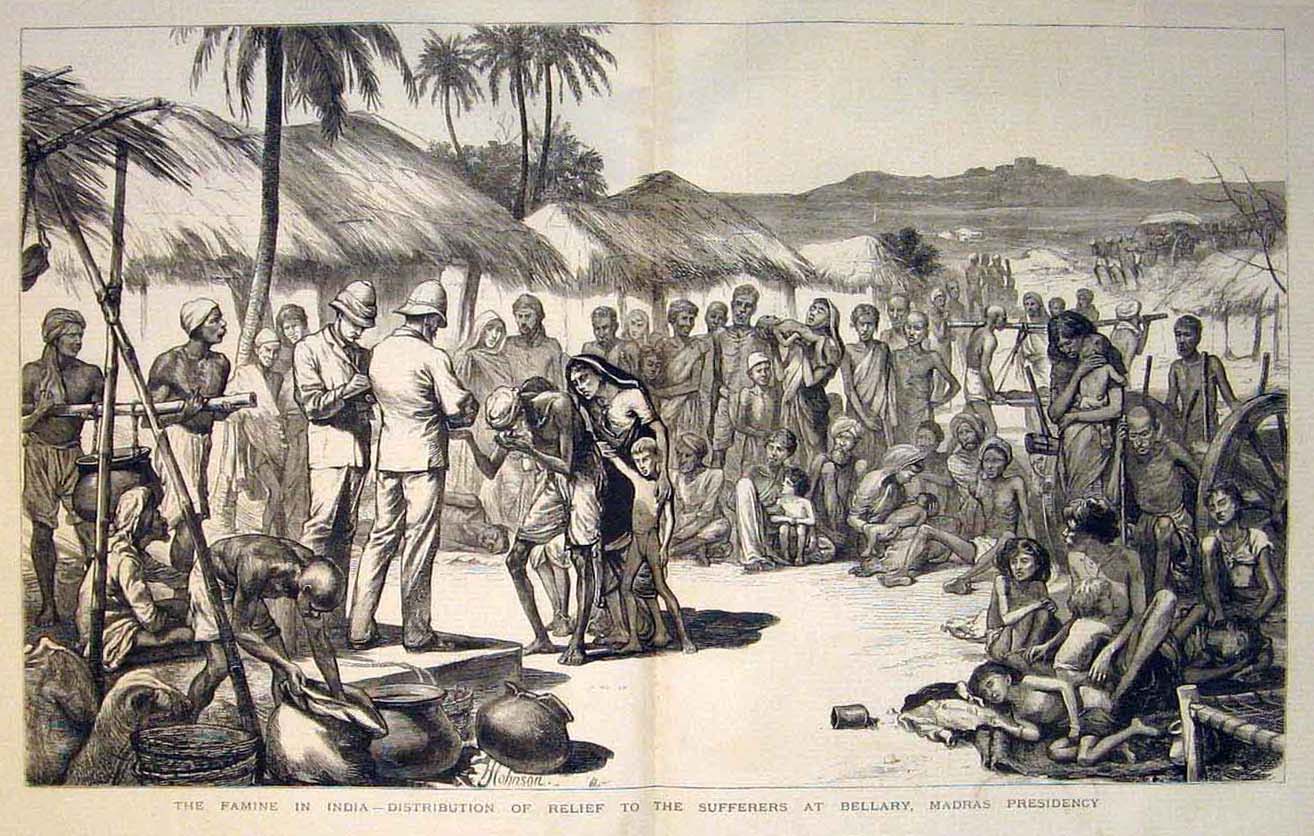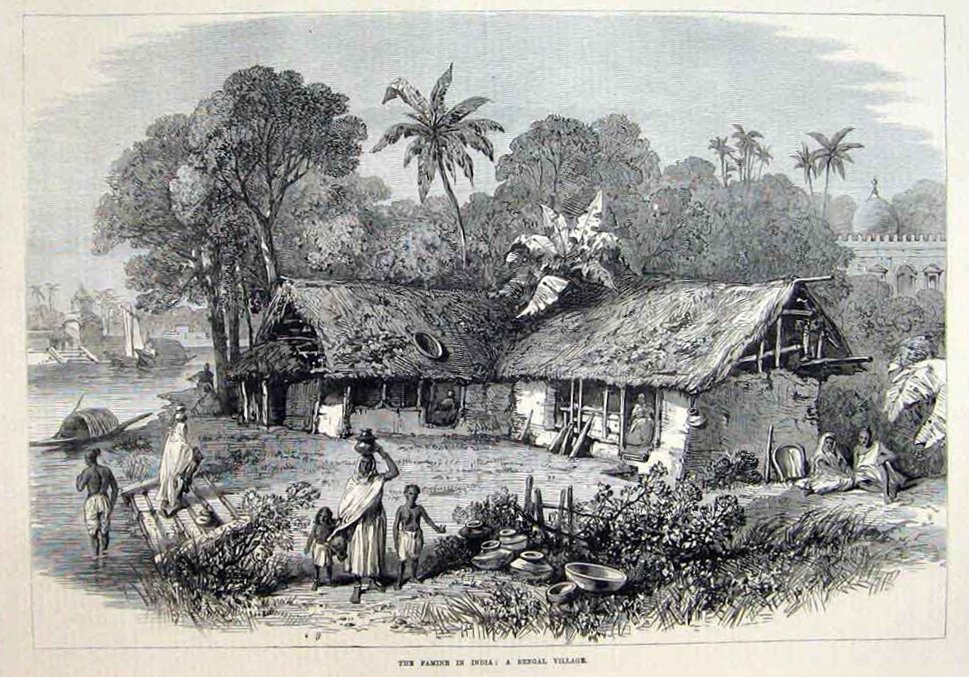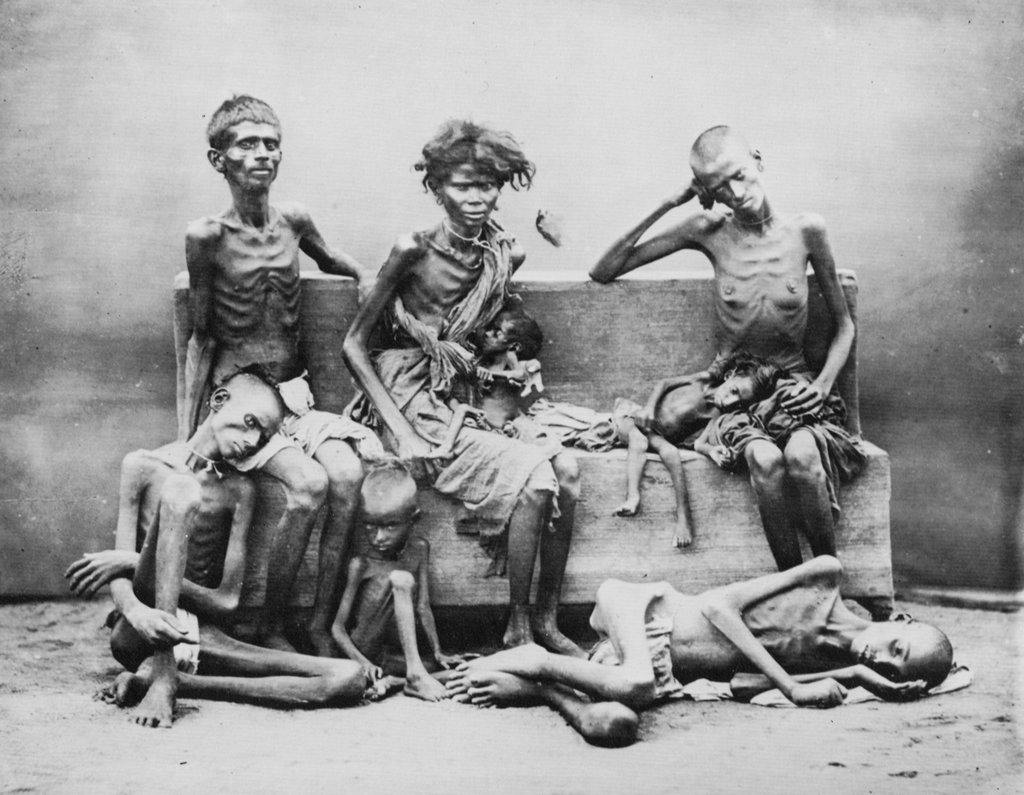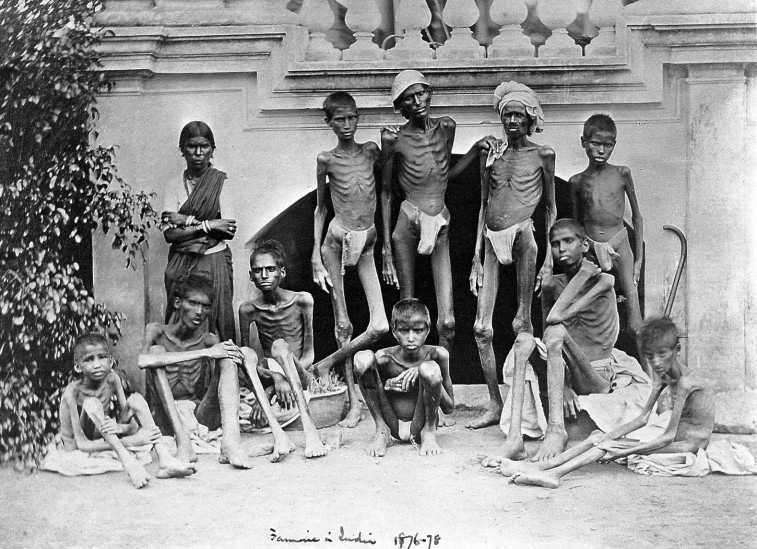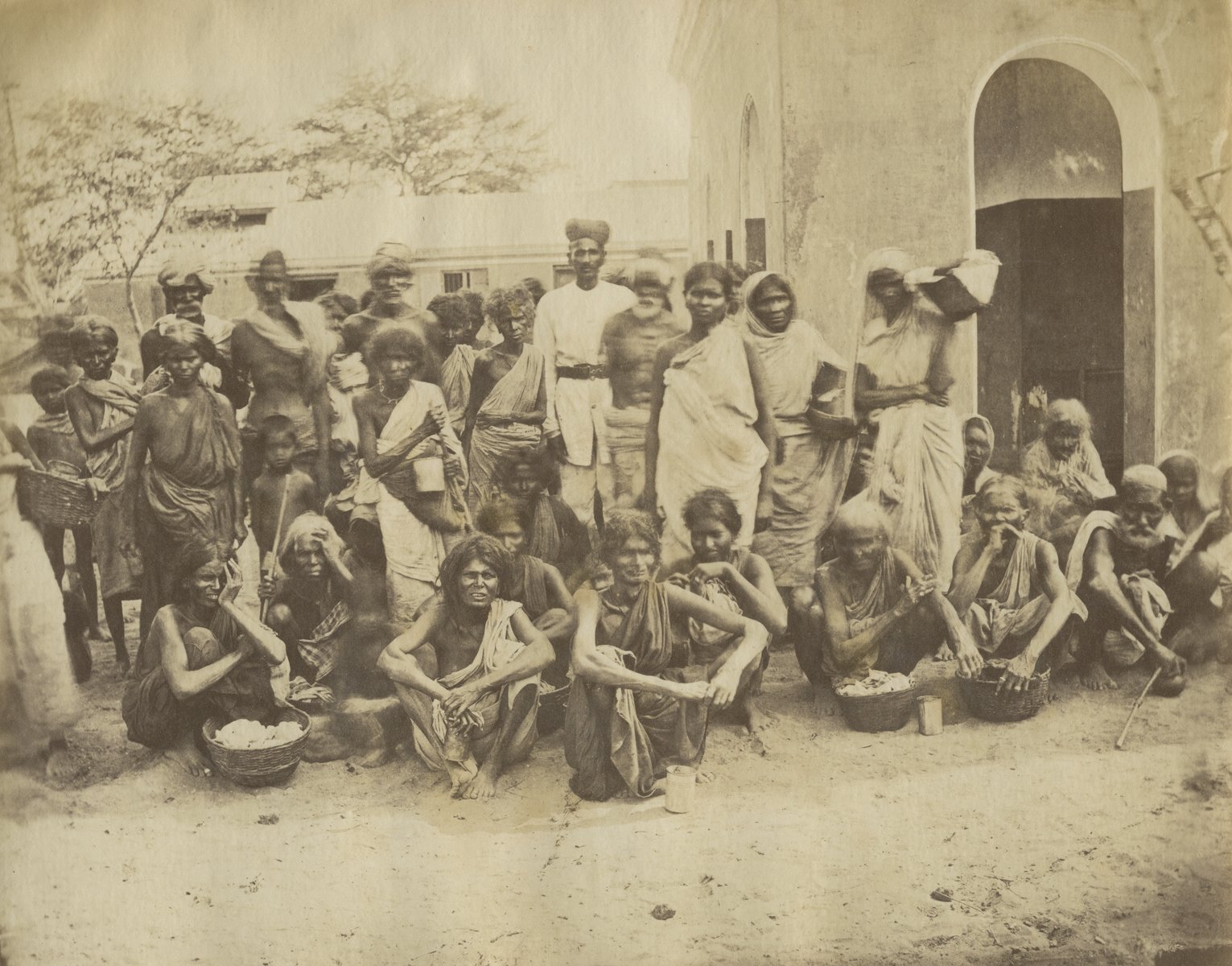During the terrible famine of 1838, according to one reporter, millions of pounds of rice and other edible grains were exported from Calcutta, to feed the kidnapped Indian Coolies, who had been sent to the Mauritius, to work in the fields. Food was exported by India’s British administration to Allied soldiers fighting in World War Two and denied to the local population. These are just the figures of the British-man-made famines, it does not include the Epidemics induced by Famines, Anglo-Indian Wars, Indians killed fighting for the British, Freedom Fighters martyred by the British. If all these are included the figures reaches over 1.8 Billion mark.
For more information, please read the full article below:
The current outbreak of food shortages and famine internationally should come as no surprise to anyone who knows the history of British imperial free-trade policy. To buttress that point, we present here indictments of that policy by two leading statesmen with personal knowledge—Abraham Lincoln’s economic advisor Henry Carey, and the founder of modern China, Sun Yat-sen—in addition to this overview article, written in 1991, from the archives of the LaRouche movement.
Before Hitler, there was Britain, and the British famine policy in India.
As many look with horror at the starvation now being induced in Africa by agencies such as the International Monetary Fund (IMF), the General Agreement on Trade and Tariffs (GATT), and the grain cartels, few know that in a previous century the British pioneered all these techniques in India. What follows is a brief outline of the British famine policy in India from 1764 to 1914, and how the British developed the deliberate use of famine and food control as the principal means of rule.
To understand the question of famine in India, one must first start with the fact that India’s climate is characterized by the monsoon, in which a region’s weather follows the pattern of a dry climate for most of the year; then comes a period of rains, which is the monsoon. At least once in the course of a decade, the monsoon fails to arrive in any given region.
Traditional agriculture in India and other countries always planned for this by laying aside foodstocks at the village level, which ensured that there would be adequate food in drought years. The central administrative authority, whether it was a Hindu prince, or the Moghul court, would suspend taxes for that period of economic insecurity. Prior to British rule, it was understood that famine needed to be avoided if the central authority was to have any legitimacy as the ruler of an area. The British changed all this.
As B.M. Bhatia writes in his 1967 book, Famines in India: “From about the beginning of the eleventh century to the end of the eighteenth there were 14 major famines in India.” This is roughly two per century. Under the period of East India Company rule from 1765-1858 there occurred 16 major famines, a rate eight times higher than what had been common before. Then, under the period of British Colonial Office rule from 1859 to 1914, there was a major famine in India an average of every two years, or 25 times the historical rate before British rule! The rest of the world’s population was growing due to technological progress, but the population of India remained at approximately 220 million for over a century prior to 1914.
Deliberately inducing a major famine more or less every two years, was, for over half a century, the backbone of British colonial policy in India.
The history of the British in India is a history of the deliberate creation of famines. Such famines resulted from the policies of the East India Company. Those policies included looting through “tax farming,” usury, and outright slavery of the indigenous population.
As we shall see, a limit to this rapine was reached in the middle of the 19th Century, leading to the first struggle for Indian independence, which began with the Sepoy Mutiny. Following that revolt, a new policy was developed by the British Colonial Office, which took over all the operations of the East India Company. The new policy revolved around creating famines in selected regions on a continuous basis, with the goal of creating a mass of starving people who could be used as slave labor, needed by the British to build the infrastructure of British rule.
East India Company Rule
The British East India Company began the administrative takeover of India in 1764-1765. The company was appointed diwan, or governor, over the area of Bengal by the collapsing Moghul Empire. The British entered India as the administrative rulers and tax collectors of the Moghul court.
As tax collectors, the previous supposedly “rapacious” Moghul agents, had collected the marketable equivalent of £818,000 sterling from the area of Bengal. In 1765-66, the first year of East India Company diwanship, the company was able to collect the equivalent of £1,470,000; and by 1790-1791, this figure had risen to £2,680,000. According to Jean Beauchamp’s British Imperialism in India, Warren Hastings, the company’s chief officer in India, wrote the following to the company’s board of directors in London:
“Not withstanding the loss of at least one-third of the inhabitants of the province, and consequent decrease in cultivation, net collections of the year 1771 exceeded those of 1768…. It was naturally to be expected that the diminution of the revenue should have kept an equal place with the other consequences of so great a calamity. That it did not was owing to its being violently kept up to its former standard.”
The great calamity mentioned was perhaps the worst famine in Indian history, which struck the provinces of Bengal, Bihar, and Orissa. It is estimated that no fewer than 10 million perished from starvation. The severity of this famine was a direct result of East India Company looting.
Tax Farming
What the Company had done to increase the tax revenue was to set up a system of “outsourcing” the right to tax the land. This is what is known as “tax farming.” The tax collector had the right to obtain as much tax as he could get, since he had bought these rights at auction. In turn, the one who was taxed, the registered landholder, called zamindari, was allowed to extract whatever he could for himself and for the tax collector from the poor peasant who worked the land.
The zamindari, who was subject only to the payment of the company’s taxes, essentially had complete power over all the land and all its cultivators.
Through this looting system, the Company left nothing in reserve for the times when the monsoons would fail. In addition, little or no maintenance was allowed for the cultivators’ infrastructure, such as the irrigation works.
The results were horrendous, as more of India’s land area came under Company rule.
The drain of wealth from India based on a tax-farming system, the destruction of native textile industry by the “free market” dumping of British textiles, and the plantation economy of opium, led eventually to a fierce resistance from the communal based population. This finally led to the Sepoy Mutiny of the zamindaris and others, especially those who lived in areas not totally under Company control. It almost broke the British Empire.
In the end, the East India Company was relieved of its rule in India and was replaced by a governor-general, and a colonial administration. The commission which recommended this change concluded that the problem was the lack of a transportation and communications infrastructure, necessary to hold subject such a vast country. Also, the commissioners concluded, there was a need for an Indian ruling class that would function as intermediaries for the British colonialists.1
Slave Labor Policy
Britain’s colonial overseers agreed on the need for the development of a rudimentary infrastructure to increase the efficiency of their rule, and looting of India. But the Empire had a problem. The proposed grid of railroads and large-scale irrigation works was too expensive, from the colonialists’ point of view. So, the decision was made to force the already plundered Indian population to pay for these development projects.
This presented another serious problem. India, at that time, did not have a landless laboring class which could provide a pool of cheap labor for such projects. The caste system of India was all-encompassing. As Bhitia documents, the ritual distribution of goods at the communal level, based on caste and guild relations, made it undesirable for families and individuals to leave this system, especially to become slaves for the British railroad and irrigation projects.
The British solution to this problem was “famine relief.” To build the railroads, the British set up “famine relief works.” A famine would create the condition, such that, faced with certain death from lack of food, an Indian would be forced to “choose” to go to a famine relief center, much like a starving famine victim in Africa would do today. However, once having done this, the individual lost his caste relations and privileges. Then he was told that if he wanted to continue to eat, he must work, building the railroad in exchange for food.
At these projects, less than minimum subsistence was the norm, much like a Nazi forced-labor concentration camp. As yesterday’s famine victims dropped dead from exhaustion and slow starvation on the railroad or irrigation project, today’s famine refugees were making their way into this socalled famine relief system. This system would today be labeled euphemistically, the “recycling” of the work force.
With the advent of railways, it became easier for traders to buy up food and other goods when they were cheap, and in some cases, even when costly, and export them to England — much in the same manner as the British let the Irish starve during the potato famine, rather than allow the wheat, barley, and rye grown in Ireland for England to be used to feed the Irish.
Under these conditions, the nature of famines and scarcities began to change. Whereas in the past, famine had been a regional phenomenon, under this British policy food became scarce throughout the country, hitting the poorest in a devastating manner. It was these famine-stricken poor who then continued to supply the labor for the relief-works.
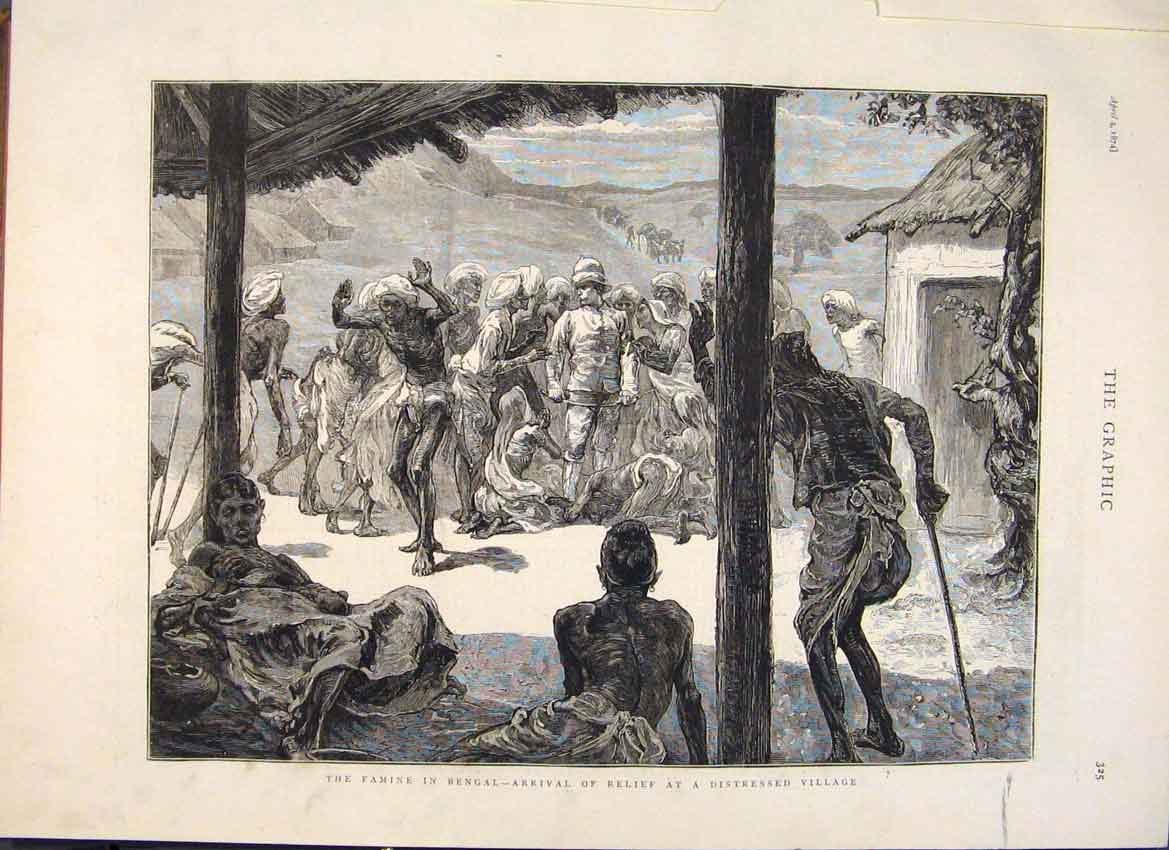
The Rise of Usury
The development of the railroads also helped to develop a class of Indian money-lenders, who became the intermediaries for the British. This allowed for the British to control even areas which were not affected by crop failures.
Such areas were hit with multiple increases in prices because of the demand placed on their food from other areas of the country. Money-lenders would then sell British goods to Indians at inflated prices, and buy their grain at low prices. Then they would sell that grain at high prices, either on the international market, or back to the same people in times of famine.
Since these transactions were carried out largely on a credit basis, vast segments of the population became debt slaves to the money-lenders, if they were fortunate enough to escape having to work on famine relief projects. In addition, the British played this system of debt-slavery off against the traditional caste and guild system, which had never had to deal with such a monstrosity.
This system brought to the fore a class of money-lenders who became the power through which the British were able to offset, in part, the resistance within India to their rule coming from the communal base.
The spread of famine throughout India can be measured in the expansion of the railroad system. There were 288 miles of rail in India in 1857; 1,599 miles in 1861; and 3,373 miles in 1865. By 1881, there were 9,891 miles; there were 19,555 miles by 1895; and 34,656 miles by 1914.
With the expansion of the railroads, and “famine relief” which built the railroads, the exports of food grains rose rapidly. The export of rice grew from12,697,983 hundred-weight in 1867-68, to 18,428,625 hundred-weight in 1877-78. Wheat exports grew 22-fold during this same period, from 299,385 hundredweight to 6,373,168 hundred-weight. The criminal nature of this policy is clearly seen, since 1876-78 were major famine years. The export of rice reached 30.3 million hundredweight, and wheat reached 30.3 million hundred-weight in 1891-92.
The worst famine was in 1896-97, which affected 62.4 million people. This resulted, among other things, according to Bhatia, in “civil commotion and unrest in Bombay against continuing exports of food grains from the presidency at a time when the people faced the threat of famine. The government of India, however, refused to change its food policy and steadfastly clung to the view so far held that, ‘even in the worst conceivable emergency, so long as trade is free to follow its normal course, we should do far more harm than good by attempting to interfere….’”
Does this sound all too familiar? The [George H.W.] Bush Administration has proclaimed a New World Order based on “free trade” and an end to the “restrictions” imposed by national sovereignty. As food and other basic resources increasingly come under the control of Euro-Anglo-American cartels, most of the world is slated to become much like India was under the British.
Bush’s New World Order is in fact nothing new, and the principal instrument of rule in this new world order is scheduled to be famine, and “famine relief” projects for the victims.
If people don’t wake up, a day will come when you may lose your cherished low-paying job, and find yourself homeless and on the soup line—only you will be told there’s no slop to eat, unless you join a work gang.
Slave labor, famine, and government-protected drug lords, like the British East India Company, are to be your masters in this New World Order. It has been done before!
Now maybe you will think twice when you view the British Broadcasting Corporation’s films of the “glorious days of the British Raj in India” which you see on PBS. British policy in India was nothing less than deliberate genocide. We face the same policy today, this time on a global scale.
China’s Sun Yat-sen on British Imperial Tyranny
In his book The Vital Problem of China, written in 1917, as a polemic against China joining the British (and the United States) in the Great War (World War I) against Germany, modern China’s Founding Father Sun Yat-sen (1866- 1925) writes that Germany stands accused of mistreating Belgium and Luxemburg. But, he notes:
“Every year, England takes large quantities of food stuffs for her own consumption from India, where in the last ten years, 19 million people have died of starvation. It must not be imagined for a moment that India is suffering from underproduction. The fact is that what India has produced for herself has been wrested away by England…. Is that any better than submarine warfare? … Nominally, of course, the British are not plundering, but in fact the exorbitant taxation and tyrannical rule in India are such as to make it impossible for the natives to maintain their livelihood; it is nothing but plunder on a grand scale.”
Sun says that England accuses Germany of asserting that “Might makes right,” but asks: “Is it right for England to rob China of Hong Kong and Burma, to force our people to buy and smoke opium, and to mark out portions of Chinese territory as her sphere of influence? [Sun notes that England has declared as its “sphere of influence” within China, all of Tibet, Sichuan, and the Yangtse Valley—28% of China’s land area.] If one really wants to champion the cause of justice today, one should first declare war on England, France and Russia, not Germany and Austria…. But China does not want to declare any war.”
Sun reports that the British waged war against France in the late 18th Century, “not because England wanted to redress any possible wrongs suffered,” but purely a policy of “rallying the weaker countries to crush the strongest, . . . simply because France in the reigns of Louis XIV and Louis XV was the strongest country in Europe…. In order to maintain her own interests, England cannot allow any country on the European Continent to grow too strong, and when any other country grows too strong, she must get all other countries to join her in overthrowing that country.”
“When another country is strong enough to be utilized, Britain sacrifices her own allies to satisfy its desires, but when that country becomes too weak to be of any use to herself, she sacrifices it to please other countries.”
Britain’s relation to its friends, wrote Sun, is like a farmer to a silkworm: “After all the silk had been drawn from the cocoons, they are destroyed by fire, or used as fish food.”
With this sense of the evil imperial character of the British, Sun forecast, correctly, that, were China to join the war on the side of the Allies, then “whether the Allies will win or not, China will be Britain’s victim.” In fact, at the Versailles Conference after World War I, Britain divided up China as spoils for those nations which had joined them in the war on Germany. He added: “It is lamentable that the would-be victims should be so willing to place themselves at the disposal of Britain and allow themselves to be tortured and mangled.”—Michael Billington
~ by Paul Glumaz as published in Executive Intelligence Wire

